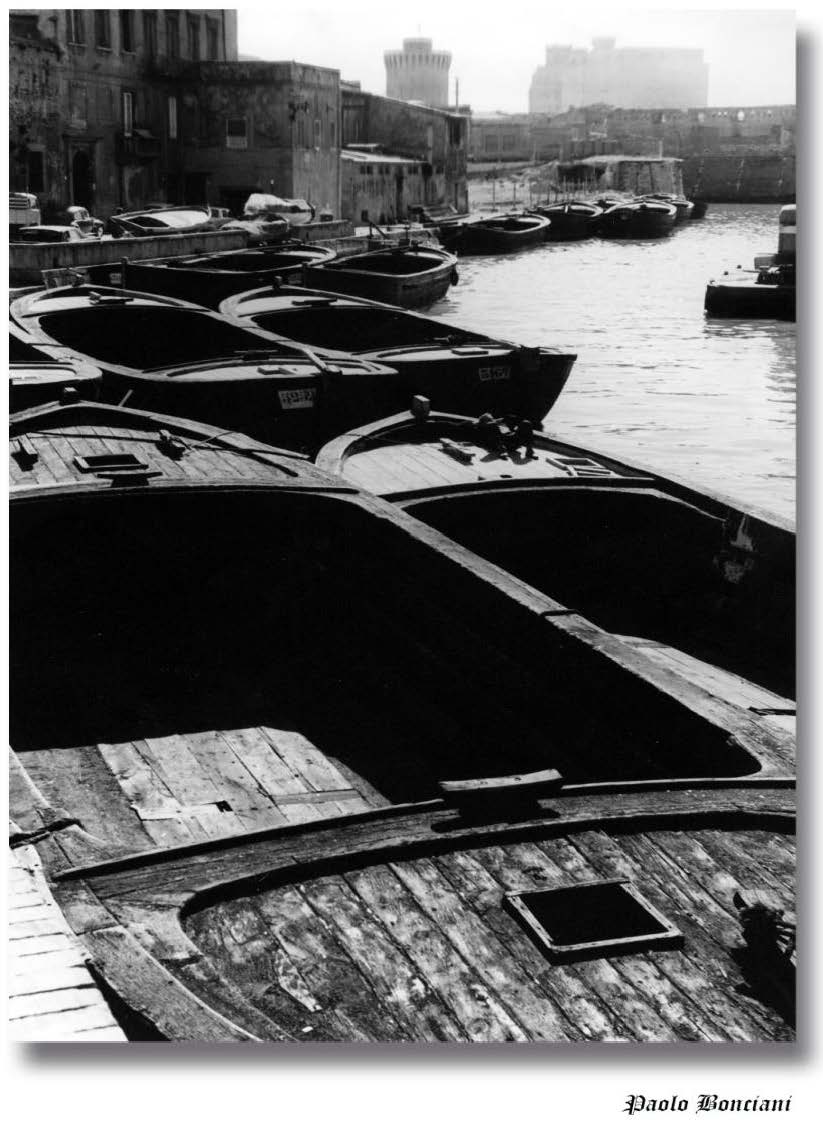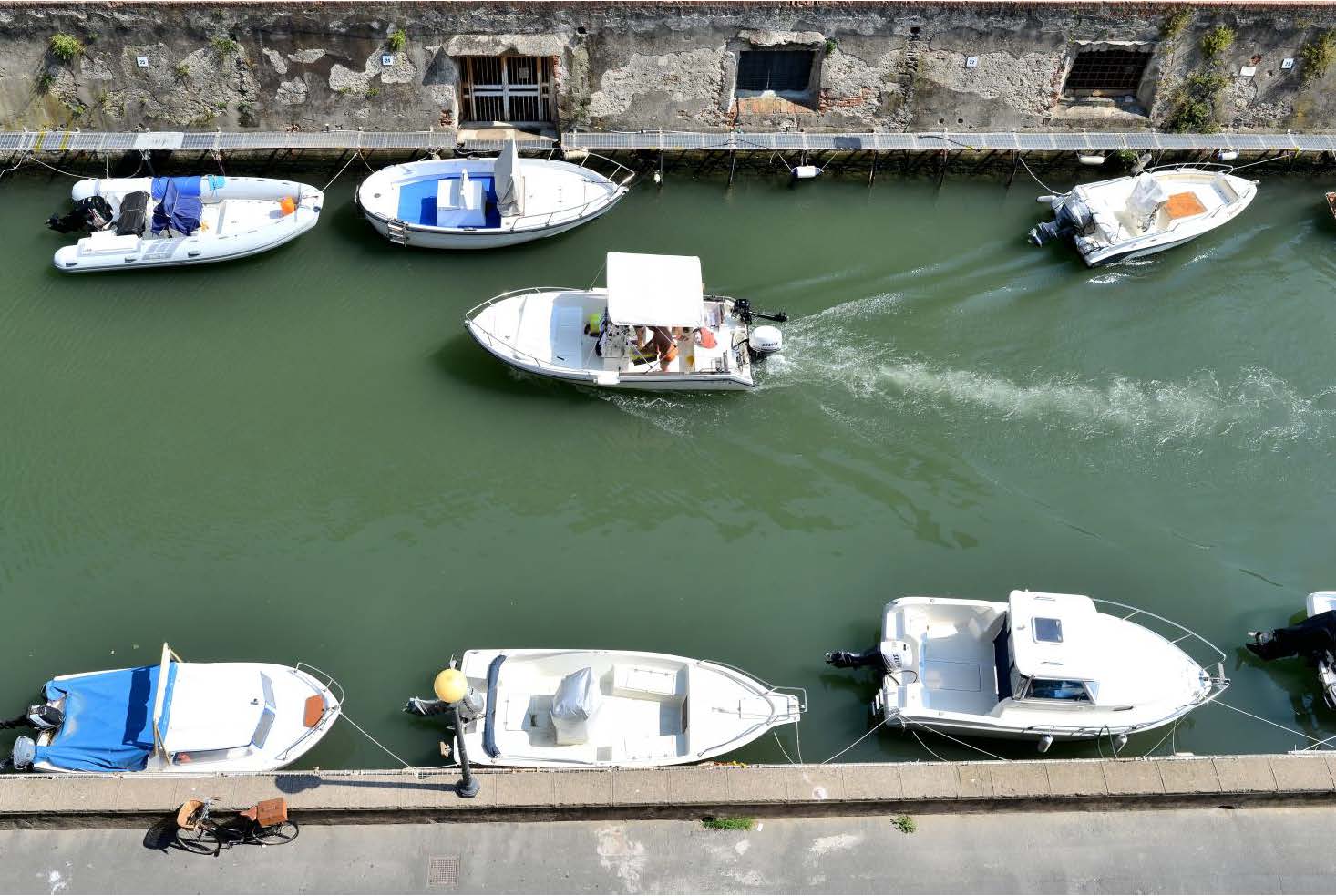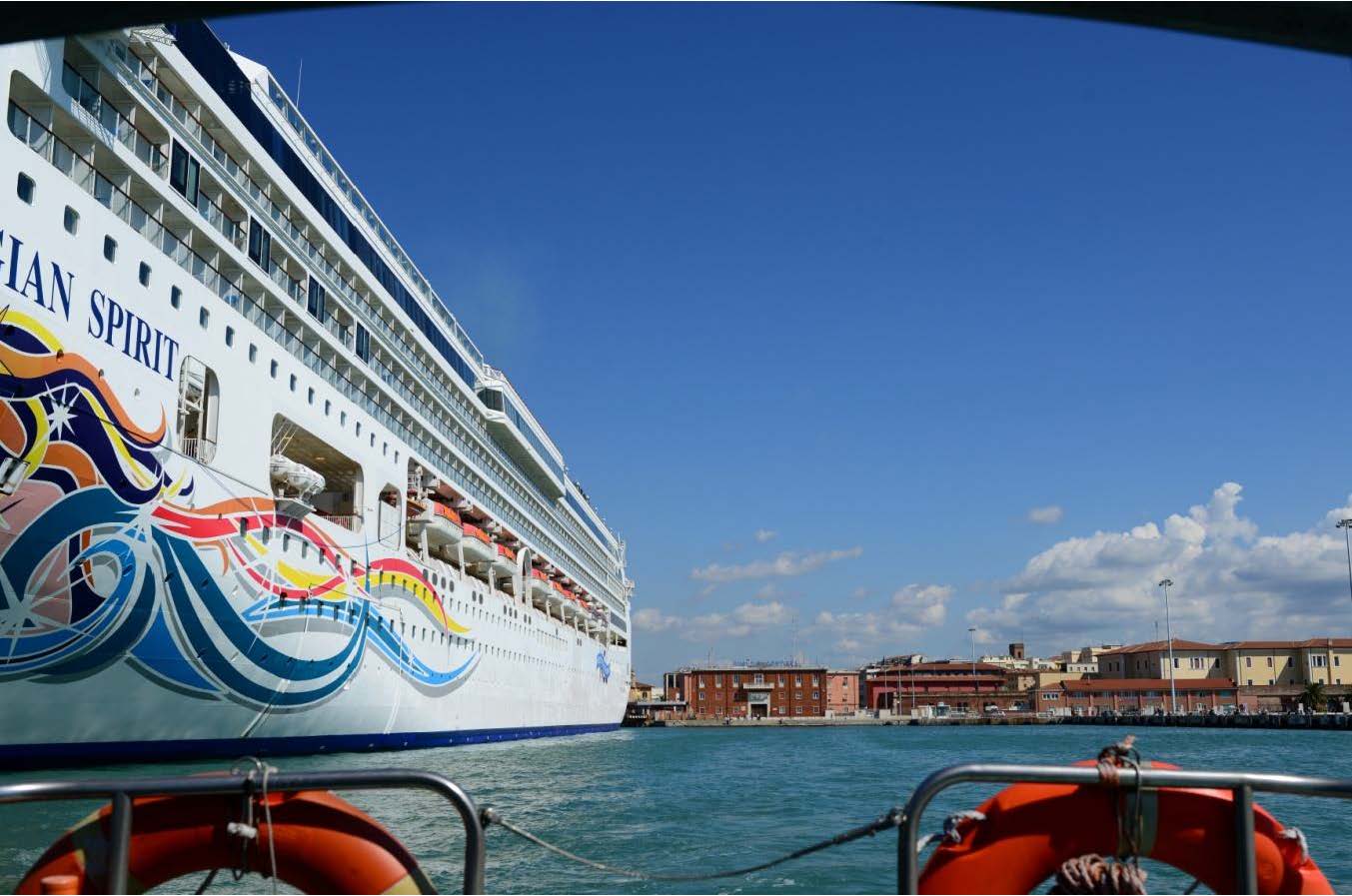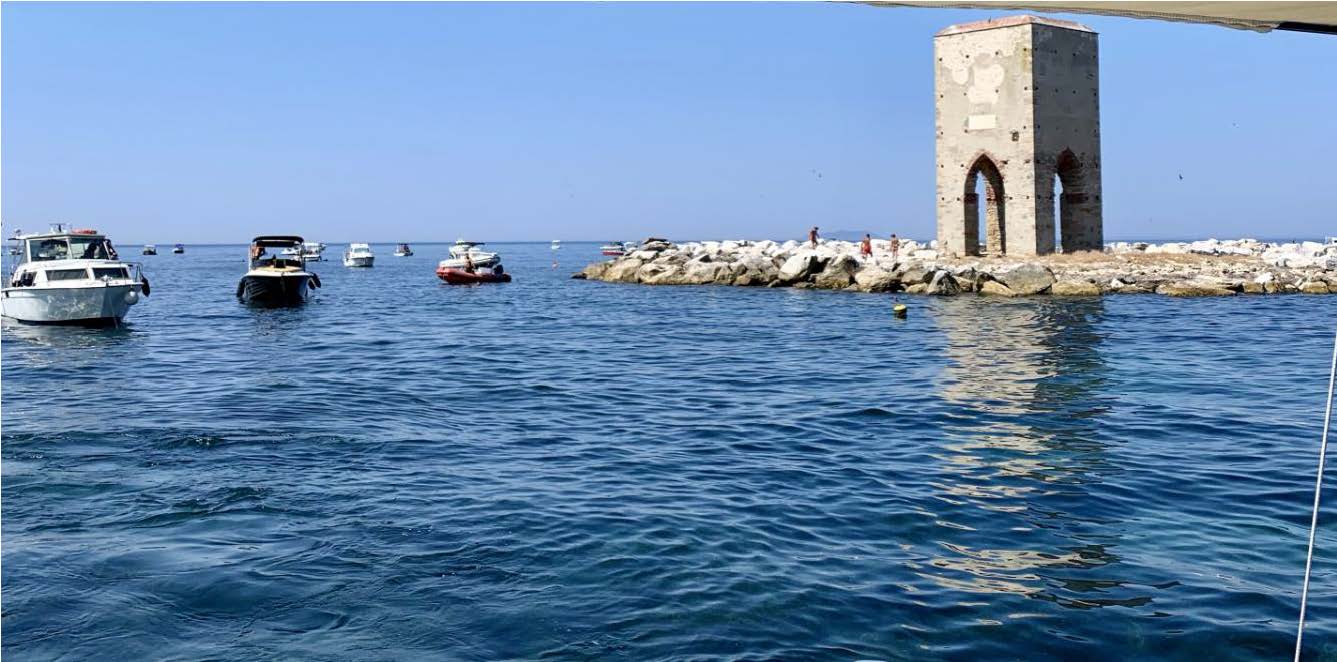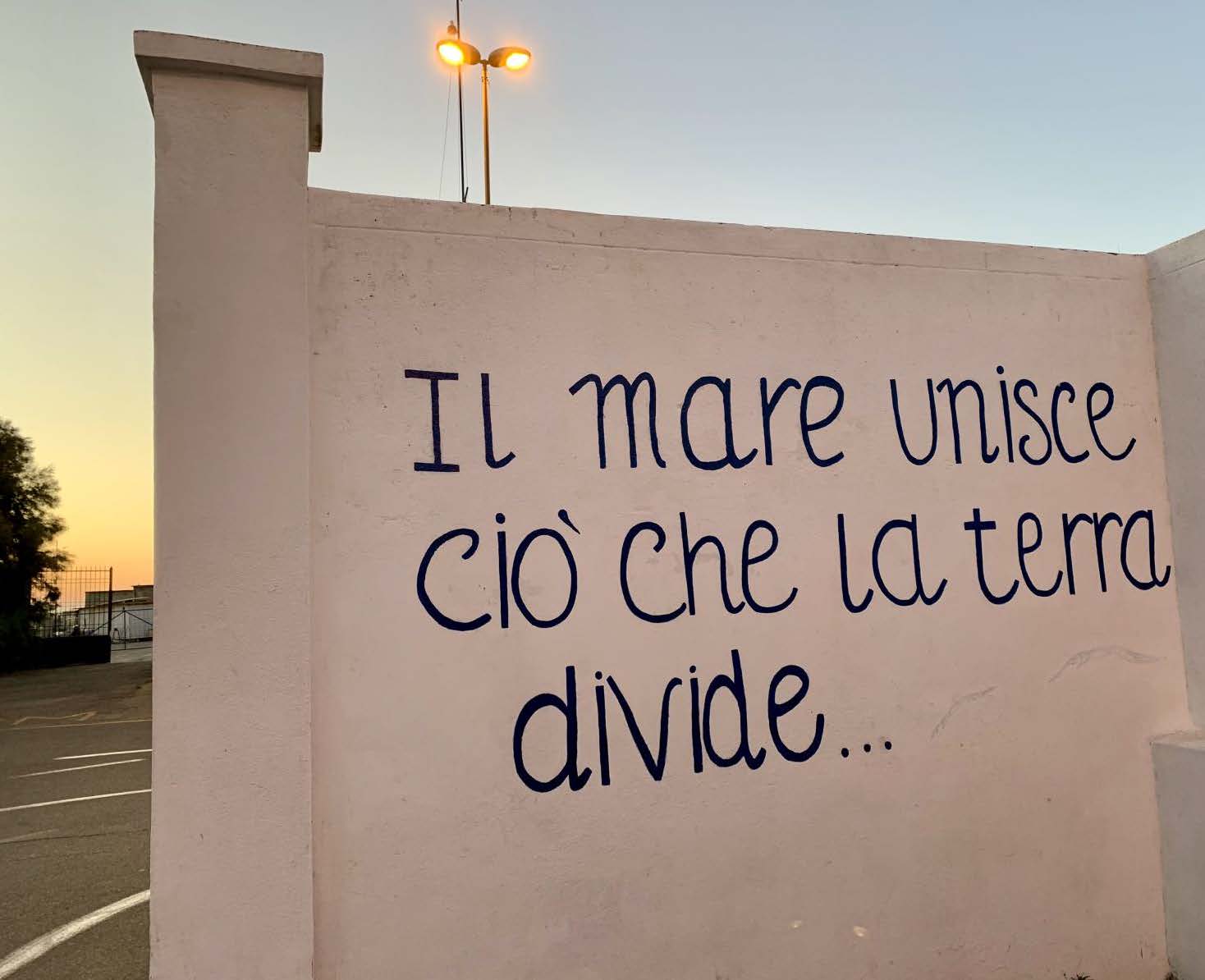The City of Livorno boasts an urban-port identity based on the distinctive stratification that characterised its origins and development and which still today permeates the mind-set and shapes the surroundings of those who live there. The sea, where ships pass and where land and water meet in the never-ending interchange of people and goods, is not only the main source of wealth for Livorno and of the collective and creative imagination of its inhabitants, it also lies at the heart of the construction of the city and of the continuous transformation of the natural and cultural fabric of the waterfront.
Livorno rose from the Tyrrhenian Sea, on the site of a tiny coastal settlement, thanks to the Medici family and soon became a densely populated city and the main port of the Grand Duchy of Tuscany, one of the busiest on the Mediterranean in the seventeenth century. Today, the city continues to claim its main economic, social and cultural vocation from the sea, so much so that port activity is the major driving force for economic development. This seafaring heritage can still be seen in the urban fabric, especially in the waterfront access of the rowing clubs in the city’s districts along the canal of the Fossi Medicei and around the harbour of the Porto Mediceo. The maritime tradition is also expressed in the numerous sailing clubs that populate the stretches of water of the urban fabric. Livorno, like many port cities, also has a great shipbuilding tradition and is home to one of the most famous shipyards in Italy of the nineteenth century, Fratelli Orlando, which was recently purchased by the Azimut Benetti group. Livorno has a new vocation as a port of call for cruise ships, which opens the city to visitors from all over the world.
View of the city (Scali Novi Lena) from the Porto Mediceo. (Photo: Paolo Pampana).
“Barchetipi” from the sea [1]
We know that for those who live near the sea, the perception of the space of the shoreline forms a conceptual and visual coordinate that permeates the identity and codes of conduct of everyday life. The sea is a sense of belonging and a fundamental part of the relationship between the people of Livorno and their city. For this reason, watercraft are the principal forms of mediation between land and sea, the extension into the water of the terrestrial habitat and a means of transport around the city or for traversing the open sea. Whatever the vessel, be it a rubber dinghy, a pleasure-, a sailing-, a fishing- or any other kind of boat, for the people of Livorno it is one of the main means for relating to their city and a way of reaching places like the Meloria Shallows, that are part of folk memory, or for sailing out to sea, for fishing or simply for spending free time in the company of friends. The boat is also an expression of the empathy that binds Livorno people to the sea, but also of that restlessness and sense of ‘anarchy’ that pushes them away from the coast in an endeavour to embrace that line of the horizon in perpetual motion. The change that has taken place in the way in which the Livorno maritime community today expresses its relationship with the sea in a ‘special’ way can be interpreted and understood from the transformation in the structure and function over time of these vessels; in this transformation, the traditional elements of the past are rediscovered and redefined in present forms and lifestyles, in which past and present find a complete synthesis.
What I like to define as “barchetipi” (barca = boat + archetypes) are precisely the result of the process of adaptation of the local maritime traditions to the historical and socio-economic transformations that have characterised the development of the port-city of Livorno. One of the most evident examples is the transformation of the urban landscape of the Fossi Medicei canal network. Originally conceived for the transport of goods, today it has become the recreational space of excellence for the “people of the little boats”, that is to say the majority of the city dwellers, who keep their boats moored there.
The photo below shows a 1960s view of the navicelli [2], the traditional boats used for the transport of goods and which testify to an era of port and river traffic that has its historical roots in the Tuscany of the Grand Duchy.
These boats, which disappeared when the Fossi Medicei canal network was no longer used to transport goods, have now been replaced, as the next photo shows, by the many pleasure boats belonging to local residents and which have radically changed not only the urban landscape but also the way in which the Fossi Medicei canals are used.
Livorno canal with “navicelli”. (Photo: Paolo Bonciani).
Fossi Medicei canal network today animated by the boats of local residents. (Photo: Paolo Pampana).
Observing the city from the sea
Looking at the coastal city from a boat, while out sailing, offers a unique insight that unites perception of the whole urban landscape of the city-port of Livorno with that of the individual features bound to the everyday life of the city.
Because of its urban layout and maritime-port identity, Livorno can be truly appreciated in all its complexity by travelling along the Fossi Medicei canals that still connect the city to the port and around the Pentagono del Buontalenti, home to the many boats of the local residents, the sailing clubs and rowing clubs; or by moving away from the coast and crossing the harbour waters that penetrate the city, in particular the areas close to the Porto Mediceo, where the view is often moderated by the sight of ships and boats at berth and in transit, fishing boats coming or going and “gozzi” with their crews. The appeal of these areas by the sea reflects the folk memory of the city, its maritime and seafaring vocation and the desire of its inhabitants to relate to the sea in a synergetic and continuous manner. Living spaces and those of tradition that remain firmly anchored in the mind of the people and in those views of their city from the sea that they treasure at all costs, as a constituent part of their urban and maritime identity. Appreciating Livorno from the sea, along its waterways or out in the open sea, changes the perception of the mainland by broadening our minds to a different form of acquaintance, enhanced by a visual appeal and a deeper understanding.
One such vision of the city is that from aboard a pilot boat as it accompanies ships’ manoeuvres on entry or exit from the port. This is one of the best ways for appreciating not only the work of these people, but also the complex and articulated series of beautiful images of the approach to the city from the sea. The proximity of the port to the city makes these visual glimpses even more significant and exciting and broadens the mind to a unique, urban and port landscape, in which the aspects of the port as a workplace, the transit of ships and the urban context find a visual synthesis that adds to our acquaintance.
The City of Livorno from the Pilot Boat. (Photo: Paolo Pampana).
Sailing through Folk Memory
In Livorno, many of the most representative places for the city’s history and maritime identity, the cornerstone of folk memory, are situated in the port area or in the area between the city and the port – such as the Old Fortress, the Fonte di Bocca, the Porto Mediceo with its historic walls, the Fossi Medicei canals that connect the city and the port and the Torre del Marzocco located in the freight port, to name but a few – and also at sea, as in the case of the Meloria Shallows. Water connects many of these places, thanks to the Fossi Medicei canal network.
These places still recall their history of the City of Livorno, on the border between land and sea, and in whose architecture, urban places and wealth of multiculturalism produced by the intersection of routes and seas, its maritime identity, a contamination of routes and traditions, can still be discovered [3]. These urban spaces today express and transmit the folk memory of the city.
In this context, Livorno is the urban expression of a community that bases its identity on its relationship with the sea and shipping.
The Torre della Meloria. (Photo: Barbara Bonciani).
Origins in the salty tang of the sea
Living in Livorno means looking towards the horizon at any time and seeing ships waiting in the harbour. It means listening to the sound of the wind and the waves, breathing in the salty sea air and walking against the wind on the days when the southwesterly “Libeccio” is blowing. This is what it means to experience the identity of Livorno and its maritime and seafaring folk memory, which is kept alive in every part of the city.
This is why, for many people from Livorno, myself included, fishing, walking or just contemplating the city from the Porto Mediceo give us the chance to rediscover ourselves and, in a blend of visual, olfactory and auditory sensations, our awareness of being a part of our maritime and seafaring tradition.
In addition to its architecture and urban landscape, Livorno as a City Port and Sea Port expresses itself through its water vessels of bygone and modern times, the fruits of a collective, creative process, which takes inspiration from and finds its raison d’être in the sea. In Livorno, urban and seafaring traditions are superimposed, mapping the appearance and fabric of the city in which past and present meet.
“Where land divides, the sea unites”, says the writing on a wall in the Porto Mediceo: maritime heritage is a factor that unites all sea communities, in space and time, in every part of the world and throughout their history.
It is from the sea that the most significant changes to the city can be observed and it is from the sea that the transformation of the city’s waterside identity can be perceived. Again from the sea, one discovers the empathy that binds Livorno to the sea and on which the dialogue between the City of Livorno and the sea is based. Acquaintance with the city can only be gained from lived experience.
Porto Mediceo.
Notes
[1] The terms Archetipi and “Barchetipi” are inspired by the work of Massimo Clemente, “Città dal Mare. L’arte di Navigare e l’arte di costruire la città”. See bibliography.
[2] The term navicello refers to two traditional Tuscan boats: the vessel used in coastal waters and the river vessel used for transporting goods, which was towed either by people known as “Alzaioli” (from alzaia, meaning towrope), or draught animals. The last remaining river “navicello” is kept in the former railway warehouse in the port area, and can be visited thanks to a restoration project carried out by the MTS Port System Authority.
[3] Livorno is a city of contamination and hybridisation. Suffice it to recall how the city befitted from the system of immunities and exemptions advanced by the Medici family, in the Livornine Laws (1591-1593), which attracted merchants from the east and the west, Jews, Marranos and Christians…. Frattarelli Fischer L., (2018) L’Arcano del mare. Un porto nella prima età globale: Livorno. Editore Pacini, Pisa.
References
Bonciani B., (2019) L’identità marittima come driver per l’integrazione sociale dei porti: Il caso dell’Autorità di sistema portuale del Mar Tirreno Settentrionale. Portus, n.37, 2019.
Bonciani B., (2015) “Turismo culturale e recupero del patrimonio storico“, in Massa M. (a cura di) Livorno: un porto e la sua città. Progetti e studi. Debatte Editore, Livorno.
Charles Landry, (2008) The Creative City. A Toolkit for Urban Innovators, Earthscan, London.
Clemente M., (2011) Città dal mare. L’arte di navigare e l’arte di costruire la città. Editoriale scientifica. Collana “Città e Architettura”, CNR Napoli.
Clemente M., (2013) “Identità marittima e rigenerazione urbana per lo sviluppo sostenibile delle città di mare.” In Towards a Circular Regenerative Urban Model. BDC, 13, n.1, Anno 2013, Università degli studi di Napoli Federico II.
Frattarelli Fischer L., (2018) L’Arcano del mare. Un porto nella prima età globale: Livorno. Editore Pacini, Pisa.
Head image: The Fortezza Vecchia (Old Fortress). (Photo: Paolo Pampana).
Livorno città di porto: archetipi e “barchetipi” dal mare
La città di Livorno vanta un’identità urbano-portuale fondata sulla stratificazione storica peculiare che ne ha caratterizzato le origini e lo sviluppo, e che ancora oggi permea la forma mentis di chi la abita e plasma gli ambienti circostanti. Il mare, principale risorsa della città, ambito di scambio continuo di genti e merce, fonte dell’ immaginario collettivo e creativo dei suoi abitanti, spazio di navigazione e di collegamento fra terra e acqua, è alla base della costruzione della città e della continua trasformazione degli approdi, del waterfront, degli elementi naturali e culturali costruiti.
Livorno è città nata dal mare, da un borgo tirrenico insalubre e insignificante, e diventata nel XVII sec., grazie alla famiglia dei Medici, una città popolosa e ricca di traffici, principale porto del Granducato di Toscana, tra i porti più trafficati del Mediterraneo. La città ancora oggi vanta dal mare la principale vocazionalità economica, sociale e culturale, tanto che l’attività portuale costituisce il principale motore di sviluppo economico. Dal mare deriva anche la cultura marinaresca che si riflette ancora oggi nel tessuto urbano, in particolare nell’affaccio a mare delle cantine remiere dei rioni cittadini, sia lungo il circuito dei Fossi Medicei, sia negli specchi acquei del Porto Mediceo. La tradizione marittima si esprime anche nei numerosi circoli nautici che popolano di barche gli specchi acquei del tessuto urbano cittadino. Livorno, come molte città di porto esprime altresì una cultura cantieristica legata alla costruzione navale, tanto da aver ospitato uno dei cantieri più famosi d’Italia, quello dei Fratelli Orlando nel XIX secolo, acquistato nei recenti anni dal gruppo Azimut Benetti. Dal mare, Livorno esprime anche una nuova vocazionalità turistica legata al traffico delle navi da crociera in transito che apre la città a visitatori provenienti da tutto il mondo.
Vista della città (Scali Novi Lena) dal porto Mediceo. (Foto: Paolo Pampana).
“Barchetipi”dal mare [1]
Sappiamo che per chi vive in prossimità del mare la percezione dello spazio della linea di costa diviene coordinata concettuale e visiva che permea l’identità e i codici di comportamento del vivere quotidiano. Il mare è senso di appartenenza e parte fondante della relazione del livornese con la propria città. Per questo, la barca costituisce il principale elemento di mediazione fra terra e mare, il prolungamento in acqua dell’habitat terrestre, un modo per navigare dentro la città o in mare aperto. La barca, che sia un gommone, una imbarcazione da diporto, a vela, un peschereccio od altro costituisce per il livornese, uno dei principali strumenti di relazione con la propria città, mezzo con cui raggiungere i luoghi della memoria collettiva, come le Secche della Meloria, oppure percorrere spazi in mare aperto, praticando attività di pesca o semplicemente spendendo tempo libero in compagnia. La barca è altresì espressione dell’empatia che lega il livornese al mare, ma anche di quell’inquietudine e senso di ‘anarchia’ che lo spinge lontano dalla costa nel tentativo di avvicinarsi idealmente a quella linea d’orizzonte in perpetuo movimento. Nelle barche, nella loro trasformazione strutturale e funzionale d’uso nel tempo, può essere letto e compreso il cambiamento intervenuto nel modo in cui la comunità marittima livornese esprime oggi, in modo ‘speciale’ il proprio rapporto con il mare; in questa trasformazione, gli elementi tradizionali del passato si riscoprono e ridefiniscono in forme e stili di vita presenti, in cui passato e presente trovano una sintesi compiuta.
Quelli che mi piace definire “barchetipi” sono proprio il risultato del processo di adattamento della cultura marittima locale alle trasformazioni storiche e socio-economiche che hanno caratterizzato lo sviluppo della città-porto di Livorno. Uno degli esempi più evidenti è la trasformazione del paesaggio urbano del sistema dei Fossi Medicei. originariamente pensato per il trasporto delle merci e oggi divenuto lo spazio ricreativo di eccellenza per “il popolo delle barchette”, vale a dire la gran parte dei cittadini che lì tiene ormeggiata la propria barca.
Nella foto seguente, scattata negli anni ‘60 sono ancora presenti i navicelli [2], vale a dire le imbarcazioni storiche deputate al trasporto delle merci, testimonianza di un’epoca di traffico portuale e fluviale che fonda le proprie origini storiche nella Toscana Granducale.
Tali imbarcazioni scomparse con la fine dell’utilizzo del sistema dei Fossi Medicei per il traffico merci, sono oggi sostituite, come visibile nella foto successiva dalle tante barche da diporto dei residenti che hanno modificato radicalmente il paesaggio urbano, oltre che le modalità di utilizzo del sistema dei Fossi Medicei.
Sistema dei fossi di Livorno con i navicelli. (Foto: Paolo Bonciani).
Il sistema dei Fossi Medicei oggi animato dalle barche dei residenti. (Foto: Paolo Pampana).
Saper guardare la città dal mare
Guardare la città di mare da un’imbarcazione, navigando, offre uno spaccato unico di comprensione della città-porto di Livorno che unisce agli approfondimenti conoscitivi urbani quelli di natura più identitaria legati all’esperienza reale della città.
Livorno è una città che per la sua conformazione urbana e per la sua identità marittimo-portuale può essere compresa nella sua complessità e profondità proprio navigando le vie d’acqua che collegano ancora in parte in modo funzionale la città al porto (sistema dei Fossi Medicei) sul Pentagono del Buontalenti, e in cui oggi sono collocate le tante barche dei residenti, i circoli nautici, le cantine delle gare remiere; oppure allontanandosi dalla costa e percorrendo gli spazi di mare che si compenetrano con la città, in particolare gli ambiti a ridosso del Porto Mediceo, in cui l’affaccio urbano è spesso mediato dalla visione di navi e da barche in sosta e transito, a cui si aggiungono pescherecci in rientro o in partenza, gozzi con equipaggi in allenamento. Le suggestioni di questi spazi antropici e urbani da mare riflettono la memoria collettiva della città, la sua vocazione marittima e marinaresca, oltre che il desiderio dei propri cittadini di relazionarsi al mare in modo sinergico e continuativo. Spazi vitali e della memoria collettiva che rimangono saldamente ancorati nella mente del livornese, in quegli affacci urbani dal mare che intende conservare a tutti i costi intatti, in quanto parte costitutiva della propria identità urbana e marittima. Comprendere Livorno dal mare, navigando le sue vie d’acqua o il mare aperto modifica la percezione della terraferma aprendo la nostra mente ad una diversa modalità di conoscenza, arricchendola di suggestioni visive che divengono spazi di approfondimento conoscitivo.
Un esempio può essere ricondotto alla visione della città che si apre realizzando un breve viaggio a mare a bordo della pilotina, vale a dire il mezzo che viene utilizzato per accompagnare i piloti a bordo nave per facilitare la manovra del vettore in ingresso e in uscita dal porto. Una delle esperienze più suggestive, che si possono fare, non solo per comprendere il lavoro di queste persone, ma anche per approcciare la città dal mare mediante suggestioni visive complesse e articolate. La vicinanza del porto alla città rende questi squarci visivi ancora più significativi e emozionanti, aprendo la mente ad un paesaggio urbano e portuale unico, in cui gli elementi del lavoro legato all’attività portuale, il transito delle navi e il contesto urbano trovano una sintesi visiva che diviene anche elemento di approfondimento conoscitivo.
La città di Livorno dalla Pilotina. (Foto: Paolo Pampana).
Navigando i luoghi della memoria collettiva
A Livorno, molti dei luoghi più rappresentativi della storia e identità marittima della città, fondamento della memoria collettiva trovano spazio prevalentemente in area portuale o nello spazio di cerniera fra città e porto (ne ricordiamo solo alcuni, come la Fortezza Vecchia, il Fonte di Bocca, il Porto Mediceo con le sue mura storiche, il sistema dei Fossi Medicei che collega funzionalmente città e porto, la Torre del Marzocco collocata nel porto commerciale), oltre che in mare aperto (Secche della Meloria). L’acqua è elemento funzionale di mediazione e collegamento fra molti di questi luoghi, grazie al sistema dei Fossi Medicei.
Questi luoghi richiamano ancora oggi la sua storia della città di Livorno, luogo di confine fra terra e mare in cui ancora riscoprire, nelle architetture, nei luoghi urbani nella ricchezza della multiculturalità prodotta dall’incrocio di rotte e mari, la propria identità marittima, le contaminazioni di rotte e culture [3]. Questi spazi urbani oggi esprimono e trasmettono la memoria collettiva della città.
In questo contesto Livorno è espressione urbana di una comunità che fonda la propria identità sul rapporto con il mare e la navigazione.
La Torre della Meloria. (Foto: Barbara Bonciani).
Matrice salmastra
Vivere a Livorno significa guardare l’orizzonte e vedere giornalmente le navi in attesa in rada, ascoltare il suono delle onde, mescolarsi con il vento, respirare area salmastra, camminare controvento nelle giornate in cui soffia il Libeccio, navigare; vivere l’identità dei luoghi urbani la memoria collettiva marittima e marinaresca conservata nei luoghi e negli spazi della città.
Per questo, pescare, camminare o contemplare la città dal mare dal Porto Mediceo significa per molti livornesi, compresa la sottoscritta, ritrovare la propria centralità, in un mix visivo e olfattivo e uditivo che richiama l’appartenenza alla cultura marittima e marinaresca.
Oltre alle forme architettoniche e urbanistiche, Livorno come città di porto e di mare si esprime nelle imbarcazioni antiche e moderne, frutto di un processo creativo comune che nel mare trova ispirazione comune e ragion d’essere. A Livorno cultura urbana e cultura marinaresca si sovrappongono definendo una visione e costruzione della città in cui passato e presente si incontrano.
“Il mare unisce ciò che la terra divide” si legge su di un muro del Porto Mediceo: la cultura marittima è un fattore che unisce tutte le comunità di mare, nello spazio e nel tempo, nelle diverse regioni del mondo e nella loro evoluzione storica.
È dal mare che si possono cogliere le modificazioni più significative della città, ed è sempre dal mare che si percepisce la trasformazione dell’identità di cui la città di mare è portatrice. Sempre dal mare si scopre l’empatia che lega il livornese al mare e su cui si fonda il dialogo della città di Livorno con il mare. La conoscenza della città può essere restituita solo dall’esperienza reale.
Porto Mediceo.
Note
[1] I termini Archetipi e “Barchetipi” sono inspirati al lavoro di Massimo Clemente, “Città dal Mare. L’arte di Navigare e l’arte di costruire la città”, riportato in bibliografia.
[2] Con il termine navicello vengono definite due tipiche imbarcazioni toscane: il navicello da mare adibito alla navigazione costiera e il navicello propriamente detto, vale a dire l’imbarcazione fluviale adibita al trasporto di merci che trae la sua propulsione dal traino effettuato mediante l’impiego di persone (Alzaioli), o animali da tiro. Oggi l’ultimo reperto di navicello propriamente detto è conservato presso il Magazzino Ex FS collocato in area portuale, visitabile grazie ad un progetto di valorizzazione realizzato dall’Autorità di sistema portuale del MTS.
[3] Livorno è città di contaminazioni e ibridazioni. Basti ricordare come il sistema di immunità ed esenzioni promosso dalla famiglia dei Medici, con l’adozione delle Leggi Livornine (1591-1593) arricchì la città della presenza di mercanti ponentini e levantini, ebrei, marrani e cristiani. Frattarelli Fischer L., (2018) L’Arcano del mare. Un porto nella prima età globale: Livorno. Editore Pacini, Pisa.
Riferimenti
Bonciani B., (2019) L’identità marittima come driver per l’integrazione sociale dei porti: Il caso dell’Autorità di sistema portuale del Mar Tirreno Settentrionale. Portus, n.37, 2019.
Bonciani B., (2015) “Turismo culturale e recupero del patrimonio storico“, in Massa M. (a cura di) Livorno: un porto e la sua città. Progetti e studi. Debatte Editore, Livorno.
Charles Landry, (2008) The Creative City. A Toolkit for Urban Innovators, Earthscan, London.
Clemente M., (2011) Città dal mare. L’arte di navigare e l’arte di costruire la città. Editoriale scientifica. Collana “Città e Architettura”, CNR Napoli.
Clemente M., (2013) “Identità marittima e rigenerazione urbana per lo sviluppo sostenibile delle città di mare.” In Towards a Circular Regenerative Urban Model. BDC, 13, n. 1, Anno 2013, Università degli studi di Napoli Federico II.
Frattarelli Fischer L., (2018) L’Arcano del mare. Un porto nella prima età globale: Livorno. Editore Pacini, Pisa.
Head image: La Fortezza Vecchia. (Foto: Paolo Pampana).

